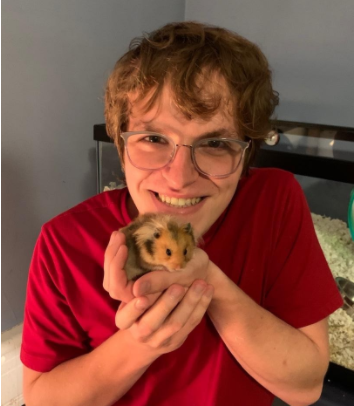The Article below was published in Vol. 136, Issue 8 of the Lake Forest College Stentor on April 30, 2021.
Amanda Rosenberg ’22
Staff Writer

Imagine you live in an apartment that is about 100-square-feet. You have no room to move around and no place to put furniture. The door is always locked, and you cannot leave. Now imagine you have four roommates.
This is the situation Waffle was living in when I found her. Waffle, a hamster, and four other hamsters were squeezed into a cage barely a foot long. Waffle and the hamsters were not the only ones living in this hoarding house. There were two dozen other animals in the same home. The animals were miserable, unhealthy, and constantly trying to escape.
I learned about Waffle’s situation through my network of friends and eventually rescued Waffle and 16 other hamsters from that house. I then found Waffle a new home and it is clear she is now loved and has become happy, energetic, and spunky.
Many people around the world consider their pets as an extension of their family. If you have ever had a pet in your life, you may relate to the idea that pets, like humans, develop a personality of their own over time. Having had many pets during my lifetime, it is clear to me that not all species of animals behave the same as one another. Take dogs, for example. Some dogs may be full of energy all the time, while others may be more relaxed.
This begs the question: how do these personalities develop in our pets? Are they born with an inherent nature that maintains their entire life or does nurture play a significant role in development? Finding answers to these questions can help us better understand why pets like Waffle change so drastically when they are rehomed into a caring and loving situation.
“Personality used to be considered an inborn tendency to behave in a certain way,” Dr. Susan Friedman, professor of animal behavior at Utah State University, said. As science has evolved, so has our understanding of personality development. “Nothing genetic is set in stone,” Friedman added. She believes that traits in an animal can always be altered based upon environment and the nurture (or lack thereof) they receive.
Still, this does not mean nature and genetics have nothing to do with an animal’s personality. According to Dee Dauber, who has fostered over 200 cats, even from when kittens are first born, some seem to be more assertive with nursing. “Size isn’t really a contribution, just personality,” Dauber added.
That is to say, many traits are inherited through genetics, starting in the womb. These kittens are observably different within even the first days of their life, even though they are all in the same environment. Some may be runts, while others “lead the pack” and take those big steps before their littermates.
To address this from a more scientific standpoint, Dr. Robert Plomin, a geneticist at King’s College London’s Institute of Psychiatry, explained that “genetics is important not only in breed differences, but also in shaping differences within a breed.” As with the kittens, genetics will influence the litter as a whole; but more importantly, each kitten individually.
“Genetics is an important factor for almost all traits, [but] that’s describing what is for a normal population,” added Plomin. “As in all of science, you can’t generalize beyond the samples you study.” Diversity within science and genetics is so wide, that it is impossible to provide a definitive answer as to why one animal may behave a certain way.
When animals are in an abusive situation, though, all bets are off, according to Plomin. “You could take a trait that’s highly heritable…but then if you abuse [an animal] they won’t develop normally,” Plomin said regarding Waffle’s abusive circumstances. To understand why abused pets behaved in a certain way comes down only to the environment. The way they adjust after they were abused is directly related to the learned experiences from that abusive environment.
There are “universal principles of behavioral health [which must be] custom fit to the individual,” said Friedman. Rather than bordering a pet by a species, one should recognize how each situation can be different. Waffle was motivated to relearn certain behaviors by positive associations with food and play. Another hamster might prefer to be left alone and have a more difficult time relearning behaviors accrued during their abuse.
Julian Greenwell, Waffle’s new owner, focused on rehabilitating her in a way that allowed her true self to shine. “Nowadays, any time I walk in on her, she’s on her wheel or just frolicking about,” said Greenwell. “Now that she’s in an environment where she knows she’s going to be fed and is comfortable, she trusts me a lot more.”
Waffle is more than just a pet to Greenwell. She’s family. “It’s really important to me, especially after her upbringing, that she gets the focus and attention she deserves. I feel like she expanded my capacity to care and to love,” Greenwell added.
The question, then, should not be a debate between nature and nurture. Rather, it is to discuss how nature and nurture work together to foster a personality in your pet. You might ask yourself, “what kind of environment was my pet born in? Do they have any genetic lineage related to breed? How does my pet’s current environment affect them?” By providing your pet with a place they can feel safe, loved, and happy, you will be able to easily determine the personality that they feel the most comfortable expressing.

